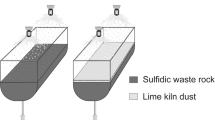Abstract
A novel technique (“bioshrouding”) for safeguarding highly reactive sulfidic mineral tailings deposits is proposed. In this, freshly milled wastes are colonised with ferric iron-reducing heterotrophic acidophilic bacteria that form biofilms on reactive mineral surfaces, thereby preventing or minimising colonisation by iron sulfide-oxidising chemolithotrophs such as Acidithiobacillus ferrooxidans and Leptospirillum spp. Data from initial experiments showed that dissolution of pyrite could be reduced by between 57 and 75% by “bioshrouding” the mineral with three different species of heterotrophic acidophiles (Acidiphilium, Acidocella and Acidobacterium spp.), under conditions that were conducive to microbial oxidative dissolution of the iron sulfide.



Similar content being viewed by others
References
Coupland K (2005) A study of the geomicrobiology of acid mine drainage-impacted environments. Ph.D. Thesis, University of Wales
Ghauri MA, Okibe N, Johnson DB (2007) Attachment of acidophilic bacteria to solid surfaces: the significance of species and strain variations. Hydrometallurgy 85:72–80
Harneit K, Göksel A, Kock D, Klock JH, Gehrke T, Sand W (2005) Adhesion to metal sulfide surfaces by cells of Acidithiobacillus ferrooxidans, Acidithiobacillus thiooxidans and Leptospirillum ferrooxidans. In: Harrison STL, Rawlings DE, Petersen J (eds) Proceedings of the 16th international biohydrometallurgy symposium. Cape Town, South Africa, p 635
Johnson DB (2003) Chemical and microbiological characteristics of mineral spoils and drainage waters at abandoned coal and metal mines. Water Air Soil Pollut Foc 3:47–66
Johnson DB, Hallberg KB (2007) Techniques for detecting and identifying acidophilic mineral-oxidizing microorganisms. In: Rawlings DE, Johnson DB (eds) Biomining. Springer, Heidelberg, p 237
Johnson DB, Rolfe S, Hallberg KB, Iversen E (2001) Isolation and phylogenetic characterisation of acidophilic microorganisms indigenous to acidic drainage waters at an abandoned Norwegian copper mine. Environ Microbiol 3:630–637
Lovley DR, Phillips EJP (1987) Rapid assay for microbially reducible ferric iron in aquatic sediments. Appl Environ Microbiol 53:1536–1540
Rohwerder T, Gehrke T, Kinzler K, Sand W (2003) Bioleaching review part A: progress in bioleaching: fundamentals and mechanisms of bacterial metal sulfide oxidation. Appl Microbiol Biotechnol 63:239–248
Rowe OF, Sánchez-España J, Hallberg KB, Johnson DB (2007) Microbial communities and geochemical dynamics in an extremely acidic, metal-rich stream at an abandoned sulfide mine (Huelva, Spain) underpinned by two functional primary production systems. Environ Microbiol 9:1761–1771
Wichlacz PL, Unz RF, Langworthy TA (1986) Acidiphilium angustum sp. nov., Acidiphilium facilis sp. nov., and Acidiphilium rubrum sp. nov.: acidophilic heterotrophic bacteria isolated from acid coal mine drainage. Int J Syst Bacteriol 36:197–201
Acknowledgements
This work was carried out in the frame of BioMinE (European project contract NMP1-CT-500329-1). The authors acknowledge the financial support given to this project by the European Commission under the Sixth Framework Programme for Research and Development. We also wish to thank our various partners on the project for their contributions to the work reported in this paper. DBJ is grateful to the Royal Society (UK) for the award of an Industrial Fellowship.
Author information
Authors and Affiliations
Corresponding author
Rights and permissions
About this article
Cite this article
Johnson, D.B., Yajie, L. & Okibe, N. “Bioshrouding”—a novel approach for securing reactive mineral tailings. Biotechnol Lett 30, 445–449 (2008). https://doi.org/10.1007/s10529-007-9574-4
Received:
Accepted:
Published:
Issue Date:
DOI: https://doi.org/10.1007/s10529-007-9574-4




